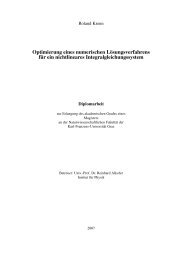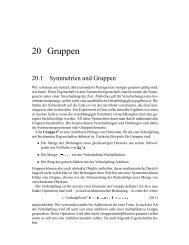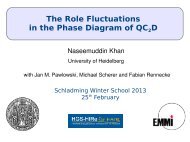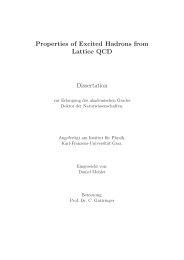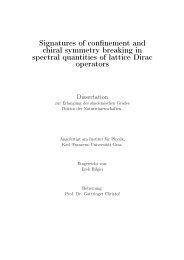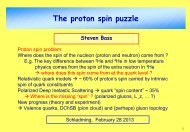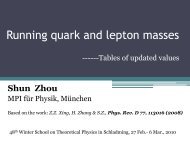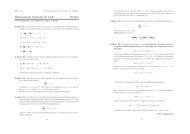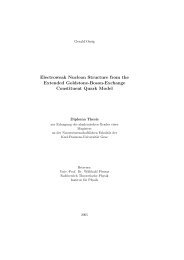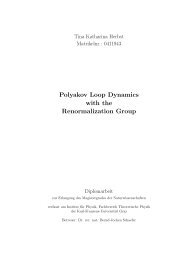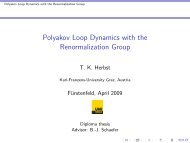The QCD Quark Propagator in Coulomb Gauge and - Institut für Physik
The QCD Quark Propagator in Coulomb Gauge and - Institut für Physik
The QCD Quark Propagator in Coulomb Gauge and - Institut für Physik
You also want an ePaper? Increase the reach of your titles
YUMPU automatically turns print PDFs into web optimized ePapers that Google loves.
Chapter 6. Nucleon Form Factors <strong>in</strong> a Covariant Diquark-<strong>Quark</strong> model 71<br />
with (T αβ (l) = δ αβ − l α l β /l 2 )<br />
This vertex satisfies:<br />
Γ [1]<br />
µαβ (l 1, l 2 ) = (l 1 + l 2 ) µ T αλ (l 1 ) T λβ (l 2 ) F 1 (l 2 1, l 2 2) , (6.65)<br />
Γ [2]<br />
µαβ (l 1, l 2 ) = [T µα (l 1 ) T βρ (l 2 ) l 1ρ + T µβ (l 2 ) T αρ (l 1 ) l 2ρ ] F 2 (l 2 1 , l2 2 ) , (6.66)<br />
Γ [3]<br />
µαβ (l 1, l 2 ) = − 1 (l<br />
2m 2 1 + l 2 ) µ T αρ (l 1 ) l 2ρ T βλ (l 2 ) l 1λ F 3 (l 2 1, l 2 2) .<br />
1 + (6.67)<br />
l 1α Γ 1+<br />
µαβ(l 1 , l 2 ) = 0 = Γ 1+<br />
µαβ(l 1 , l 2 ) l 2β , (6.68)<br />
which is a general requirement of the elastic electromagnetic vertex of axial-vector bound<br />
states <strong>and</strong> guarantees that the <strong>in</strong>teraction does not <strong>in</strong>duce a pseudoscalar component <strong>in</strong><br />
the axial-vector correlation. We note that the electric, magnetic <strong>and</strong> quadrupole form<br />
factors of an axial-vector bound state are expressed [HP99]<br />
G 1+<br />
E (Q2 ) = F 1 + 2 3 τ 1 + G1+ Q (Q2 ) , τ 1 + =<br />
Q2<br />
4 m 2 1 + (6.69)<br />
G 1+ M(Q 2 ) = −F 2 (Q 2 ) , (6.70)<br />
G 1+<br />
Q (Q2 ) = F 1 (Q 2 ) + F 2 (Q 2 ) + (1 + τ 1 +) F 3 (Q 2 ) . (6.71)<br />
Extant knowledge of the form factors <strong>in</strong> equations(6.64)–(6.67) is limited <strong>and</strong> thus one<br />
has little <strong>in</strong>formation about even this rudimentary vertex model. Hence, we employ the<br />
follow<strong>in</strong>g ansätze:<br />
F 1 (l 2 1 , l2 2 ) = ∆ Π 1+(l2 1 , l2 2 ) , (6.72)<br />
F 2 (l 2 1, l 2 2) = −F 1 + (1 − τ 1 +) (τ 1 +F 1 + 1 − µ 1 +) d(τ 1 +) (6.73)<br />
F 3 (l 2 1 , l2 2 ) = − (χ 1 + (1 − τ 1 +) d(τ 1 +) + F 1 + F 2 ) d(τ 1 +) , (6.74)<br />
with d(x) = 1/(1+x) 2 . This construction ensures a valid electric charge normalisation for<br />
the axial-vector correlation,<br />
lim<br />
l ′ →l Γ1+ µαβ (l′ , l) = T αβ (l) d (l 2 ) l2 ∼0<br />
= T<br />
dl 2 Π1+ αβ (l) 2 l µ , (6.75)<br />
ow<strong>in</strong>g to equation(6.47), <strong>and</strong> current conservation<br />
<strong>The</strong> diquark’s static electromagnetic properties follow:<br />
lim<br />
l 2 →l 1<br />
Q µ Γ 1+<br />
µαβ (l 1, l 2 ) = 0 . (6.76)<br />
G 1+<br />
E (0) = 1 , G1+ M (0) = µ 1 + , G1+ Q (0) = −χ 1 + . (6.77)



